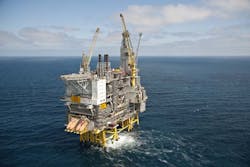Good news continues for Norwegian oil giant Statoil. Shortly after it announced what is considered to be the biggest oil discovery in the North Sea for decades, the company said it had made a new discovery in the area, this time in the Grane field.
According to an official statement from Statoil last week, the find is estimated to hold between 18 million and 33 million barrels of recoverable oil. It was drilled by the rig Songa Trym and the well proved an oil column of 20 meters in the Heimdal Formation, Statoil explained. The site is located just north of the Grane field and is further proof of the efficient near-field exploration strategy adopted by the company. Near-field exploration is a process in which resources are sought in the immediate vicinity of existing fields, with the potential for allowing the use of operating installations and saving some capacity for future development. Statoil said that approximately 40 percent of its exploration wells this year on the Norwegian Continental Shelf would be near-field exploration.
The discovery was made near exploration well 25/11-27 in the Grane Unit in the North Sea. Statoil is operator at the field and holds a share of 36.66 percent. Its partners are Petoro AS (28.94 percent), ExxonMobil Exploration & Production Norway AS (28.22 percent) and ConocoPhillips Skandinavia AS (6.17 percent), the company said.
Tore Loseth, Statoil's vice president for exploration in the North Sea, commented that the discovery would result in new very high value resources that can be developed effectively. Despite the fact that the amounts are not as big as some recent finds, oil there is of high quality and can be extracted fast. This find would be an important addition to the portfolio and would matter for the extension of the production life of existing installations, Loseth explained.
RELATED: Statoil granted 15 Gulf of Mexico leases
Meanwhile, Statoil has been granted the Petroleum Safety Authority Norway's consent to use the production facility on the Gudrun field in 15/3 in the central part of the North Sea. Oil, condensate and gas from Gudrun will be carried through two pipelines to Sleipner A for processing and export. Production from the Gudrun field is expected to start in the first quarter of next year.
Norway is the largest oil producer in Europe and the second-largest exporter of natural gas after Russia. Its oil and gas industry plays a crucial role for the national economy and, because of its paramount importance, it is widely supported by the Norwegian government. Last month the government announced that it was recommending the opening of southern waters in the Barents Sea to energy explorers for the first time since 1994. It is predicted that the region may hold more than one billion cubic feet of oil equivalent.

